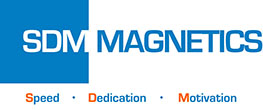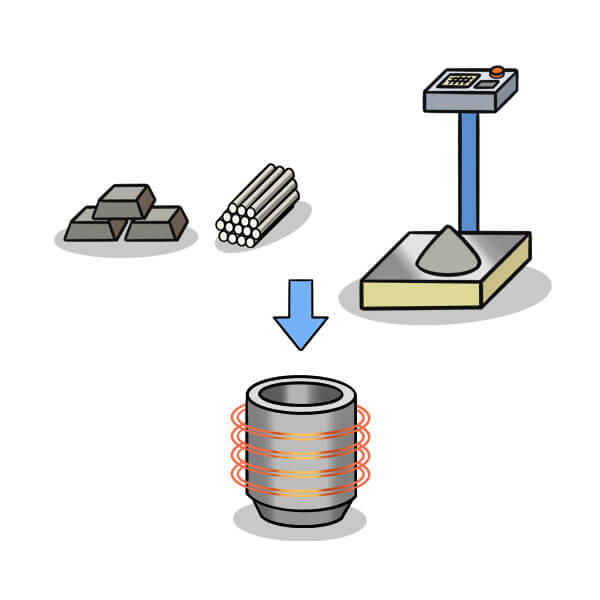Neodymium magnet is still the most powerful and frequently used rare earth permanent magnetic material nowadays. Neodymium magnet can be classified to into sintered Neodymium magnet, bonded Neodymium magnet, and hot pressed Neodymium magnet in accordance with the manufacturing process. Each form has their different magnetic properties, then their overlapped application scope is less and under a complementary relationship. Magnet users are wondering how are Neodymium magnets made. Sintered Neodymium magnet is produced by conventional powder metallurgy process and occupies an absolute predominance in market share.
How Are Neodymium Magnets Made?
Sintered Neodymium magnet is prepared by the raw materials being melted under vacuum or inert atmosphere in an induction melting furnace, then processed in the strip caster and cooled to form Nd-Fe-B alloy strip. Alloy strips are pulverized to form a fine powder with several microns in diameter. The fine powder is subsequently compacted in an orientation magnetic field and sintered into dense bodies. The bodies are then machined to the specific shapes, surface treated and magnetized.
Weighing
Weighing of qualified raw material is directly related to the accuracy of magnet composition. Purity or raw material and stability of chemical composition is the foundation of product quality. Sintered Neodymium magnet normally select rare earth alloy like Praseodymium-Neodymium Pr-Nd mischmetal, Lanthanum-Cerium La-Ce mischmetal, and Dysprosium Iron Dy-Fe alloy as material for cost reason. High melting point element Boron, Molybdenum, or Niobium are added in ferroalloy way. Rust layer, inclusion, oxide, and dirt on the raw material surface need to remove by microblasting machine. In addition, raw material should be in suitable size to fulfill the efficiency in subsequent melting process. Neodymium possess low vapor pressure and active chemical properties, then rare earth metal exists a certain degree of volatilization loss and oxidation loss during melting process, therefore, weighing process of sintered Neodymium magnet should consider add additional rare earth metal to ensure accuracy of magnet composition.
Melting and Strip Casting
Melting and strip casting is crucial to composition, crystalline state, and distribution of phase, thus impact subsequent process and magnetic performance. Raw material are heated to molten state via medium and low frequency induction melting under a vacuum or inert atmosphere. Casting can be processed when the alloy melt realized homogenization, exhaust, and slagging. A good cast ingot microstructure should possess well-grown and fine-sized columnar crystal, then Nd-rich phase should distribute along the grain boundary. In addition, cast ingot microstructure should be free of α-Fe phase. Re-Fe phase diagram indicate that rare earth ternary alloy is inevitable to produce α-Fe phase during slow cooling. Room temperature soft magnetic properties of α-Fe phase will seriously damage magnetic performance of magnet, thus must be inhibited by rapid cooling. In order to satisfy desired rapid cooling effect to inhibit the production of α-Fe phase, Showa Denko K. K., developed Strip Casting Technology and soon became routine technology within the industry. Uniform distribution of Nd-rich phase and the inhibitory effect on α-Fe phase can effectively reduce the total content of rare earth which favorable to manufacture high performance magnet and cost reduction.
Hydrogen Decrepitation
Hydrogenation behavior of rare earth metal, alloys, or intermetallic compounds and physicochemical properties of hydride have always been the important issue on rare earth application. Nd-Fe-B alloy ingot also exhibits very strong hydrogenation tendency. Hydrogen atoms enter interstitial site between intermetallic compound main phase and Nd-rich grain boundary phase and formed interstitial compound. Then interatomic distance increased and lattice volume expanded. The resulting internal stressing will produce grain boundary cracking (intergranular fracture), crystal fracture (transcrystalline fracture), or ductile fracture. These decrepitation come with crackling and are therefore known as hydrogen decrepitation. Hydrogen decrepitation process of sintered Neodymium magnet is also referenced as HD process. Grain boundary cracking and crystal fracture that generated in hydrogen decrepitation process made Nd-Fe-B course powder very fragile and highly advantageous to subsequent jet milling process. In addition to enhancing efficiency of jet milling process, hydrogen decrepitation process is also favorable to adjust the average powder size of fine powder.
Jet Milling
Jet milling has proven to be the most practical and efficient solution in powder process. Jet milling utilizing a high speed jet of inert gas to accelerate coarse powder to supersonic velocity and impact powder into each other. The basic purpose of powder process is seeking appropriate average particle size and particle size distribution. The difference of above features exhibits different characteristics in macroscopic scales which directly impact on powder filling, orientation, compacting, demolding and microstructure generated in sintering process, thereupon then sensitively influence magnetic performance, mechanical properties, thermoelectricity, and chemical stability of sintered Neodymium magnet. The ideal microstructure is fine and uniform main phase grain surrounded by smooth and thin additional phase. Besides, easy magnetization direction of main phase grain should be arranged along orientation direction as consistent as possible. Voids, large grains, or soft magnetic phase will lead to significantly reduce in intrinsic coercivity. Remanence and squareness of the demagnetization curve will simultaneously decrease while easy magnetization direction of grain deviate from the orientation direction. Thereby, alloys should be pulverized to the single-crystal particle ranging from 3 to 5 microns in diameter.
Compacting
Magnetic field orientation compacting is referred to utilize the interaction between magnetic powder and the external magnetic field to align powder along the easy magnetization direction and make it consistent with the final magnetization direction. Magnetic field orientation compacting is the most common path to manufacture anisotropic magnet. Nd-Fe-B alloy has been crushed into the single crystal particle in previous jet milling process. Single crystal particle is uniaxial anisotropy and each of them has merely one easy magnetization direction. Magnetic powder will transform into the single domain from multi-domain under the action of external magnetic field after loosely filled into mold, then adjust its easy magnetization direction c-axis to be consistent with external magnetic field direction via rotating or moving. C-axis of alloy powder basically retained its arrangement status during compacting process. Compacted parts should proceed demagnetization treatment before demolding. The most important index of compacting process is orientation degree. Orientation degree of sintered Neodymium magnets is determined by various factors, include orientation magnetic field strength, particle size, apparent density, compacting method, compaction pressure, etc.
Sintering
The density of the compacted part can achieve more than 95% of theory density after processed sintering process under high vacuum or pure inert atmosphere. Therefore, voids in the sintered Neodymium magnet are closed which ensured uniformity of magnetic flux density and chemical stability. Since permanent magnetic properties of sintered Neodymium magnets are closely related to its own microstructure, heat treatment after sintering process is also critical to the adjustment of magnetic performance, especially intrinsic coercivity. Nd-rich grain boundary phase is serving as the liquid phase which able to promote the sintering reaction and restore surface defects on the main phase grain. Sintering temperature of Neodymium magnet is commonly ranging from 1050 to 1180 degrees Celsius. Excessive temperature will lead to grain growth and decrease intrinsic coercivity. In order to obtain ideal intrinsic coercivity, squareness of the demagnetization curve, and high temperature irreversible loss, sintered Neodymium magnet usually needs to process two-stage tempering heat treatment at 900 and 500 degrees Celsius.
Machining
In addition to regular shape with moderate size, sintered Neodymium magnet is hard to directly achieve required shape and dimensional accuracy at one time due to the technical limitations in the magnetic field orientation compacting process, thereby, machining is an unavoidable process to the sintered Neodymium magnet. As a typical cermet material, sintered Neodymium magnet is considerable hard and brittle, then there are merely cutting, drilling, and grinding can be applicable to its machining process among conventional machining technology. Blade cutting typically utilize diamond coated or CBN coated blade. Wire cutting and laser cutting are well suited to the machining of special shaped magnet, but accused of low production efficiency and high processing cost in the meanwhile. Drilling process of sintered Neodymium magnet is primarily adopted diamond and laser. It is necessary to select trepanning process when the inner hole of the ring magnet larger than 4mm. As the by-product in trepanning process, trepanned core can be used for manufacturing other suitable smaller magnet and thus significantly enhance material utilization ratio. Grinding wheel for copy grinding is produced on the basis of the grinding surface.
Surface Treatment
Surface protective treatment is a necessary procedure for the Neodymium magnet, especially sintered Neodymium magnet. Sintered Neodymium magnet possesses multi-phase microstructure and consists of Nd2Fe14B main phase, Nd-rich phase, and B-rich phase. Nd-rich phase exhibit very strong oxidation tendency and will constitute the primary battery with main phase under humid environment. A small amount of substitutional elements is capable of enhance chemical stability of magnets, but come at the cost of magnetic performance. Therefore, protection of sintered Neodymium magnet is primarily aimed at its surface. Surface treatment of sintered Neodymium magnet can be classified into wet process and dry process. Wet process refers to magnets are processed surface protective treatment in pure water or solution. Wet process includes phosphate, electroplating, electrolessplating, electrophoresis, spray coating, and dip coating. Dry process refers to magnets are processed surface protective treatment through physical or chemical process without contact with solution. Dry process generally contains physical vapor deposition (PVD) and chemical vapor deposition (CVD).
Magnetization
The majority of permanent magnets are magnetized prior before serving for their intended applications. Magnetization process refers to applying a magnetic field along the orientation direction of the permanent magnet and achieved technical saturation with the increased external magnetic field strength. Each type of permanent magnetic material needs distinct magnetic field strength to fulfill technical saturation in magnetization direction. Remanence and intrinsic coercivity will be less than its due values unless external magnetic field strength lower than technical saturation magnetic field. Permanent magnet can be divided into isotropic type and anisotropic type according to whether has an easy magnetization direction or not. As an anisotropic magnet with high intrinsic coercivity, sintered Neodymium magnet need to be magnetized via impulse magnetization. The capacitor will be charged after rectification, then the electrical energy in capacitor instantaneous discharge to the magnetizing fixture. Magnetizing fixture can generate the pulsed magnetic field during the instantaneous strong current through it. Therefore, permanent magnet in coil will be magnetized. There are various magnetization patterns can be achieved on sintered Neodymium magnet so long as not conflicting with its orientation direction.









